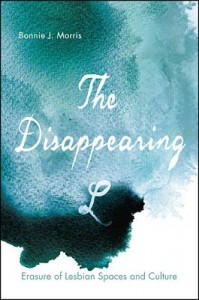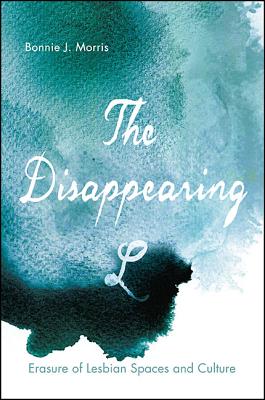 The Disappearing L: Erasure of
The Disappearing L: Erasure of
Lesbian Spaces and Culture
by Bonnie J. Morris
SUNY. 256 pages, $22.95
IN THE DISAPPEARING L, Bonnie J. Morris writes about a current cultural reality: the potential extinction of lesbian spaces that threatens to take 20th-century radical feminist history down with it. She asks the question: “How do we apply scholarly standards to radical history?” And her book can be read as a model for how to do just that. Morris weaves an artful quilt of scholarly research, primary source material, and personal anecdotes in an effort to preserve the history of quickly vanishing, uniquely lesbian-identified spaces.
In her introduction, Morris writes: “We are witnessing the almost flippant dismissal of recent, late 20th-century lesbian culture, particularly the loss of physical sites such as women’s bookstores and women’s music festivals and their material legacies (books, journals, albums, tapes, magazine interviews with artists).” The Disappearing L is itself a piece of material culture, created to preserve late 20th-century lesbian history while marking the ever-broadening circumference of its erasure.
Morris’ passion is the women’s (or “womyn’s”) music scene of the 1970s, ’80s, and ’90s, and I found the chapters on this topic the most compelling. At the outset, she describes her thirty-year effort to record information and collect material from lesbian musicians, employees, and participants at these events. She writes fondly of her days as a young lesbian at the Michigan Womyn’s Music Festival, where she took copious notes and felt an extraordinary camaraderie and acceptance. She includes excerpts from her journal documenting these experiences, which reveal a young voice that is beautiful and energetic.

Morris discusses the rationale for women-only spaces and the political difficulties that emerged from those who had different ideas about inclusion. Should there be a space for women with children (including male children) at the festival? A teen space? The politics underlying each festival were often quite intense, and sometimes conflict burst into the open. In the context of the Michigan Festival, a controversy erupted in 2013 around transwomen’s desire to be included in the festival. Morris offers a balanced perspective that neither praises nor defends the approach of festival leadership toward this controversy. In my view, a fuller articulation of the separatist argument would have been justified, particularly since this side has been substantially silenced by the closing of the festival in 2015.
A chapter called “Hunting and Gathering” describes women’s bookstores as pre-Internet spaces where lesbians could find connection both with other women and with books by lesbian feminists. This chapter also provides information about lesbian studies in the academy, including Morris’ argument that the dominance of queer theory has tended to come at the expense of earlier lesbian writing. Of queer theory she writes: “although exciting and important, it had the impact of obscuring women’s lives … with a critical academic language that distanced grassroots lesbian activists.”
A chapter titled “Imagining an Eruv” considers why a great number of Jewish-identified lesbians were among the first to become lesbian-feminist activists. Did an emphasis on education and multiple viewpoints in Judaism come into play? Was Jewish resistance to mainstream culture a model for lesbian separatism? Morris is a born cataloguer, and here (as elsewhere) she enumerates a large number of names of prominent lesbians—but without always explaining their individual contributions.
Morris ends on a regretful note suggested by the book’s title: regret over the loss of lesbian spaces and events, and an argument that what’s most important now is not to lose a record of the past. Morris herself has certainly done her part to further this goal, most recently in an excellent article in Slate.com (Dec. 22, 2016) aimed at a broad on-line audience. I hope many people will read The Disappearing L for its expansive and multi-layered rendering of the main ideas presented in Morris’ shorter works. In The Disappearing L, she gives young women-loving-women many reasons to hang on to the “L” rather than let it fade away.
________________________________________________________
Elizabeth Catanese is a writer, a visual artist, and an assistant professor of English at Community College of Philadelphia.






